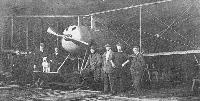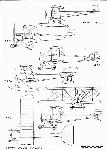
Описание
Страна: Великобритания
Год: 1913
C.Barnes Bristol Aircraft since 1910 (Putnam)
In January 1913 Coanda designed a central-float seaplane, which resembled in some ways the G.E.3 and may have owed something to it, for the fuselage was faired to a circular section and mounted midway between the wings; the fuel tanks and system were also arranged in the same way as in Gordon England's design. On completion, this seaplane, No. 120, was sent to Cowes and was fitted with a wide central float built of mahogany designed by Oscar Gnosspelius, who had pioneered the design of hydroplanes on Lake Windermere and had produced similar floats for seaplanes. Stability afloat was ensured by two small torpedo-shaped floats under the wing-tips; there was no tail-float, but two water rudders were fitted at the rear of the main float. The two tandem cockpits had dual handwheel controls and there was a gap between the upper wing-roots above the front cockpits. The 80 h.p. Gnome was installed in a close-fitting aluminium cowling and had a starting handle in the cockpit, with an interconnected hand-starting magneto. A standard Coanda rudder and tailplane were fitted, but an extra rectangular rudder was later added under the tail to offset the keel surface of the main float. In the early buoyancy tests, the Gnosspelius float was satisfactory, but after being moored out for some days it soaked up an excessive weight of water and at his first attempt Busteed was unable to take-off. He therefore arranged with S.E. Saunders and Co. of Cowes to build a specially light float, using their patent wire-sewn plywood; this float was attached to the seaplane during the first week in April, and on the 15th Busteed succeeded in taking-off. His troubles had only just begun, however, for the Gnome engine was too closely cowled and quickly overheated. Losing power rapidly, Busteed had to alight abruptly and the impact was too much for the lightweight float, which burst open, throwing the pilot into the Solent. He was a strong swimmer, but was near exhaustion before being seen and rescued half an hour later by a dredger.
No. 120, although begun as a private venture, had been purchased, subject to acceptance trials, by the Admiralty and was to have carried the R.N.A.S. number 15. The Admiralty had also ordered a landplane derived from the Coanda monoplane; this was a fairly straightforward conversion of No. 121, which had returned to Filton in February 1913 for overhaul after service at the Larkhill school since the previous October. It thus became the prototype of the Gnome-engined biplane known as the T.B.8, and in July and August at Larkhill soon showed that it had a much better performance than the B.R.7. It was next converted into a twin-float seaplane, for which purpose No. 120's original Gnosspelius float was divided down the centre line and made into a pair of narrower floats. In this form, with a steerable tail float and extra fin area added, No. 121 was sent to Dale on Milford Haven on 20 September 1913. It was flown through all its tests satisfactorily by Busteed and his assistant G. B. Dacre, until rough weather made further flying impossible. It was then returned to Filton in December, stripped, overhauled and rebuilt with a new fuselage as No. 205 and delivered to Calshot as the agreed substitute for No. 120, receiving the latter's intended serial 15. It had a tendency to fly nose down and in April 1914 it was again rebuilt at Filton with new floats, staggered wings with ailerons and a revised fin; in this form it was flown at the Spithead naval review in July 1914. Before agreeing to accept No. 205, it seems that the Admiralty had asked for a larger seaplane, and drawings have survived of a project called B.C.2, showing a tandem two-seater with a fuel system similar to No. l20's, and a circular monocoque fuselage, with a 200 h.p. eight-cylinder watercooled Clerget engine, for which Coanda designed an ingenious two-speed reduction gear, with internal clutches for changing speed, in place of the chain gear formerly employed. The design is dated between April and June 1913, after which it seems to have been discontinued.
Model Hydro 120 T.B.8H
Power Plant 80 hp 80 hp
Gnome Gnome
Span 38 ft 8 in 37 ft 8 in
Length 27 ft 10 in 30 ft 6 in
Wing Area 436 sq ft 450 sq ft
Duration 4 hours
Accommodation 2 2
Production 1 1
Sequence Nos. 120 205
Описание:
- C.Barnes Bristol Aircraft since 1910 (Putnam)
- M.Goodall, A.Tagg British Aircraft before the Great War (Schiffer)
- P.Lewis British Aircraft 1809-1914 (Putnam)
Фотографии
-
C.Barnes - Bristol Aircraft since 1910 /Putnam/
Busteed and party with No. 120 at Cowes, April 1913, showing original float.
-
M.Goodall, A.Tagg - British Aircraft before the Great War /Schiffer/
Bristol Coanda seaplane at Cowes for testing by Harry Busteed.
-
P.Lewis - British Aircraft 1809-1914 /Putnam/
The Bristol Coanda Hydro-biplane floating off Cowes in March, 1913.
-
P.Lewis - British Aircraft 1809-1914 /Putnam/
Bristol T.B.8 Hydro-biplane shown at Dale during July, 1913, in its original form. The prototype converted to a seaplane.
-
C.Barnes - Bristol Aircraft since 1910 /Putnam/
Busteed taxying No. 121 at Dale in September 1913.
-
C.Barnes - Bristol Aircraft since 1910 /Putnam/
Harry Busteed on T.B.8 seaplane at Dale in September 1913.
-
C.Barnes - Bristol Aircraft since 1910 /Putnam/
Другие самолёты на фотографии: Bristol BR.7 - Великобритания - 1913Bristol TB.8 / GB.75 - Великобритания - 1913







